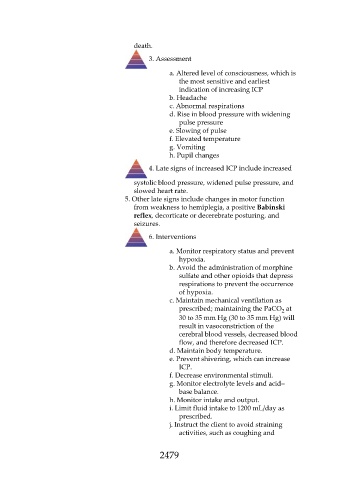Page 2479 - Saunders Comprehensive Review For NCLEX-RN
P. 2479
death.
3. Assessment
a. Altered level of consciousness, which is
the most sensitive and earliest
indication of increasing ICP
b. Headache
c. Abnormal respirations
d. Rise in blood pressure with widening
pulse pressure
e. Slowing of pulse
f. Elevated temperature
g. Vomiting
h. Pupil changes
4. Late signs of increased ICP include increased
systolic blood pressure, widened pulse pressure, and
slowed heart rate.
5. Other late signs include changes in motor function
from weakness to hemiplegia, a positive Babinski
reflex, decorticate or decerebrate posturing, and
seizures.
6. Interventions
a. Monitor respiratory status and prevent
hypoxia.
b. Avoid the administration of morphine
sulfate and other opioids that depress
respirations to prevent the occurrence
of hypoxia.
c. Maintain mechanical ventilation as
prescribed; maintaining the PaCO at
2
30 to 35 mm Hg (30 to 35 mm Hg) will
result in vasoconstriction of the
cerebral blood vessels, decreased blood
flow, and therefore decreased ICP.
d. Maintain body temperature.
e. Prevent shivering, which can increase
ICP.
f. Decrease environmental stimuli.
g. Monitor electrolyte levels and acid–
base balance.
h. Monitor intake and output.
i. Limit fluid intake to 1200 mL/day as
prescribed.
j. Instruct the client to avoid straining
activities, such as coughing and
2479

